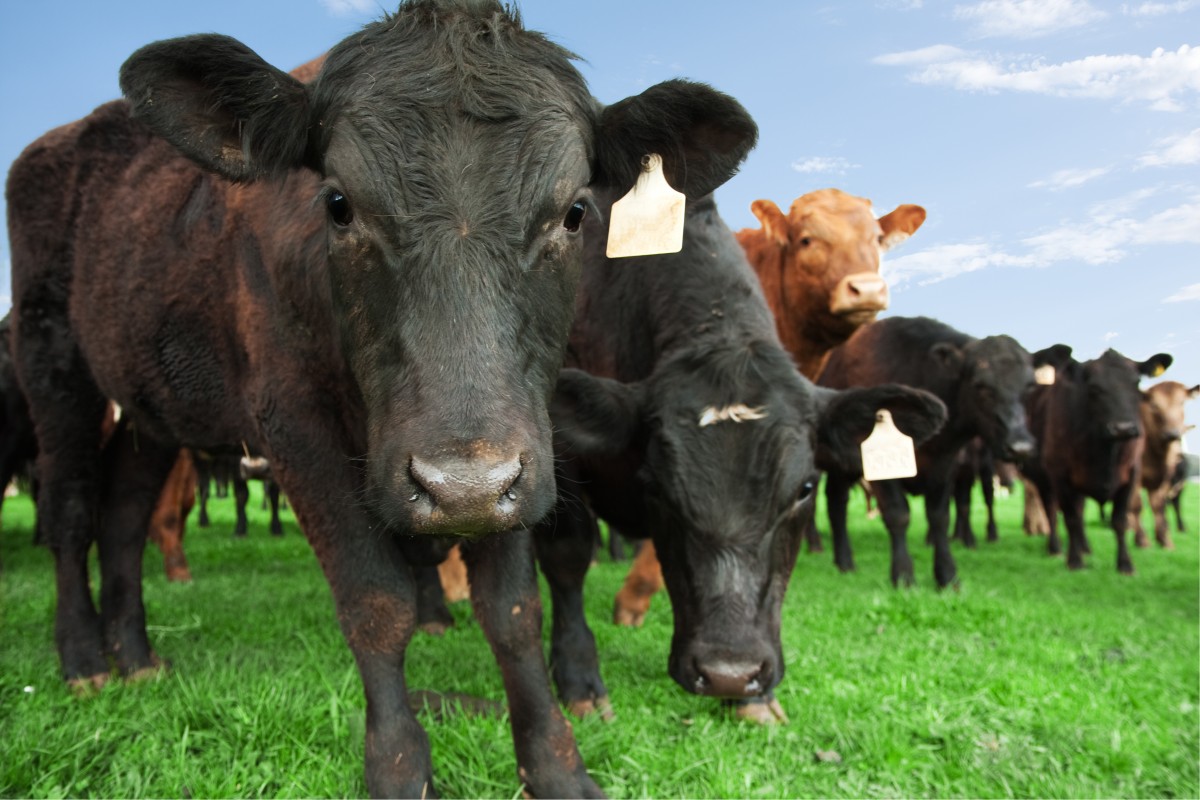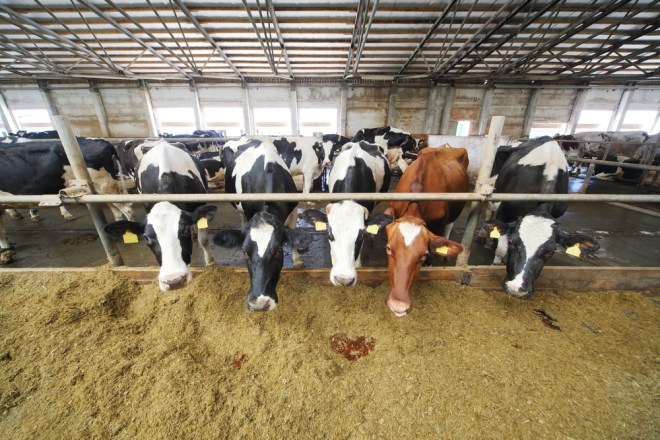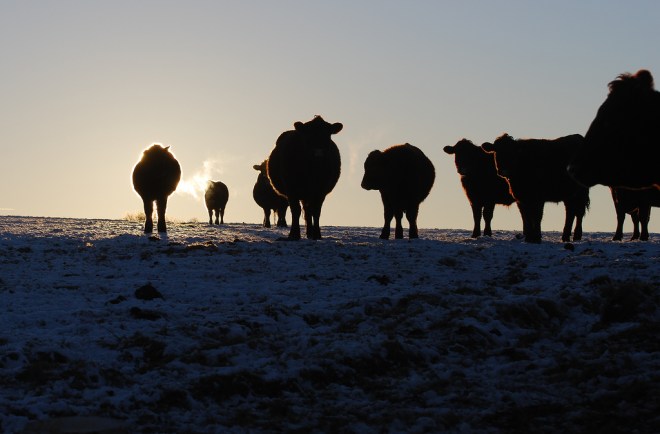The prevailing rhetoric coming from the environmental, dietary, and vegetarian communities paints cattle as perfectly designed agents of personal and planetary demise. From both ends of a cow’s alimentary canal, a climate toxin — methane — spews forth that is so heat-trapping, it makes carbon dioxide look like an amateur. The flesh and mammary secretions of bovines will make you fat, give you heart disease, and sour your soul with bad karma. Simply put: If you want to die, go to hell, and take the whole world with you, all in one obscene gesture, then go eat a cheeseburger.
And we do. Although beef consumption is down in the U.S. in recent decades, worldwide consumption of meat, beef included, is set to double by 2050.
This projected increase, along with environmental damages caused by cattle, is why beef eating is becoming less and less PC in the green community.
Climate-fearing omnivores have sought refuge for their consciences by eating grass-fed beef, believing it’s less taxing to the Earth, but some scientists are now arguing that grain-fed beef may actually be more climate friendly than free-range beef.
The idea that grass-fed cattle are such a burden on the Earth is, in so many words, bullshit, according to Nicolette Hahn Niman, author of the new book Defending Beef. But it’s an idea that she bought into herself, during college in the 1980s, and held onto for years.
“I drank the Kool Aid. I quit eating beef and enthusiastically embraced the attitude that no beef was good beef,” Niman writes. She went on to become a practicing environmental lawyer. Then she married a rancher. Then she become one.
Today, Niman believes, and argues, that cattle can help many ecosystems become healthier and absorb carbon. Properly managed cattle can encourage biodiversity — and be integral parts of many human cultures, Niman writes. And while still a vegetarian herself, Niman argues that if people want to eat beef, there are health benefits to doing so.
Obviously, some red flags appear when a rancher chimes in on a debate over whether ranching is good or evil. I called up some scientists to get outside perspectives on the science that Niman touts. Before I go there, here’s a primer on Niman’s argument against the beef haters.
The anti-beef movement really gathered steam, Niman writes, with the 2006 publication of a report by the U.N. Food and Agriculture Commission, “Livestock’s Long Shadow.” The report attributed 18 percent of the world’s greenhouse gas emissions to livestock, with cattle contributing the most. “By the following year, everyone from animal rights and environmental advocacy groups to the New York Times editorial board was treating the report’s 18 percent figure as the gospel truth,” Niman writes.
Niman has all kinds of beef with this calculation. For example, she points out that it includes carbon dioxide released from the clearing of tropical forests in Brazil, Sudan, Indonesia, which during the 1990s accounted for as much as 35 percent of greenhouse gas emissions. The FAO report pinned the blame for these emissions on the aggregated meat industry, she writes, “equally blaming farmers and ranchers the world over for deforestation taking place in very specific regions.”
As Niman deconstructs that 18 percent figure, she argues that properly managed, pastured beef can improve soils and sequester carbon, and discusses research into different ways that cattle methane emissions can be reduced — such as by adding nutrients to salt licks.
Not surprisingly, Niman’s thesis is a tough sell in many parts of the environmental community. Emily Cassidy, a research analyst at the Environmental Working Group, acknowledges via email that cattle can have beneficial impacts on the soil. But, she writes, “There are a lot of scientific leaps to be assumed from [improved] soil fertility to offsetting the methane emissions from cattle.”
The main problem with grass-fed beef, she writes, is it “takes at least twice as long to reach slaughter weight [than grain-fed beef], and during this time beef cattle continue to emit methane, a greenhouse gas ~30 times as potent as carbon dioxide.”
Cassidy says she’s seen no credible evidence that carbon sequestration from grazed lands outweighs the methane emissions, and referred me to this study.
Doug Boucher, director of Climate Research and Analysis at the Union of Concerned Scientists, chimed in via email from the recent climate summit in Peru. His take echoes Cassidy’s, but he is quick to point out that this doesn’t mean feedlots are the answer: Grain feeding of cattle can be, and is, done on a small scale on family farms. But the bottom line, he wrote, is that supplemental feeding reduces emissions per kilo of beef.
Niman isn’t against supplemental feeding, providing most of a cow’s life is on pasture. Her claim that pastured cattle can sequester enough carbon to offset their methane emissions rests largely (though not entirely) on the work of ecologist Allan Savory, who advocates short duration, intensive grazing by dense herds of ungulates, with the animals being moved frequently. Savory believes such grazing stimulates plant growth, while the action of cattle hooves mixes their manure into the soil, along with plant seeds, aerating the earth and allowing for water penetration. Savory’s 2013 Ted Talk created a wave of hopeful salivation among beef-eating environmentalists, as well as its share of criticism from other corners.
Boucher points out that Savory’s ideas have never been published in peer-reviewed journals and subjected to the scrutiny of the scientific community.
Niman, reached by phone, responds that her book cites several peer-reviewed studies, such as this, and this, that come to conclusions similar to Savory’s.
Savory’s basic premise is that many of the Earth’s ecosystems were once covered by enormous populations of large grazing animals, Niman tells me. “That’s not in dispute. The next question is whether or not you need those animals for proper function of ecosystems.” Savory argues that we do, Niman says, and that cattle can function as a proxy for these disappeared animals, such as the tens of millions of buffalo that were hunted to near extinction in North America.
If, for the sake of argument, we accept that the health of some ecosystems can improve under properly managed cattle, the meat of the pastured beef debate comes down to how much carbon sequestration this might amount to, and how it compares to the methane emitted by those cattle.
“There’s no doubt that pastures generally have more carbon than cropland,” Boucher says, “but that’s quite different from showing that they are accumulating carbon at rates that are sufficient to outweigh the negative climate impact of the methane that the cattle emit.”
According to a 2011 study published by the Union of Concerned Scientists, “Raising the Steaks,” the amounts of carbon sequestration by pasture, and methane emissions by cows, are not set in stone. The report concludes that managing forage crops to improve their nutritional quality could reduce methane emissions by as much as 30 percent, and that improvements in forage species could help cattle reach marketable weight sooner, resulting in shorter cow life spans, and less methane.
It all comes down to the efficiency with which plants are converted into meat, the study’s author Doug Gurian-Sherman tells me by phone. And while people eating plants directly is the most efficient way to create human meat, Gurian-Sherman says, it doesn’t mean that eating beef should be off the table. “There are roles that livestock play in the world in terms of food economies and producing high quality protein that are important,” he says. “Meat production needs to be at a sustainable level.”
For better or for worse, if we assume beef eating isn’t going to end, the question becomes, what is the most efficient way to feed cows?
Corn is a very efficient feed, which is why CAFO (Concentrated Animal Feeding Operation) beef can produce less methane, Gurian-Sherman says. But some forage plants are more efficient than corn, and there is a huge amount of untapped potential in this regard. “Corn efficiency has gone up tremendously after receiving decades of serious investment. We’ve done almost no research in improving forage crops,” he says. “I’ve no doubt that we could improve forage crops if we put some effort into it.”
As for the carbon sequestration potential of grasslands, Gurian-Sherman describes a 2010 study that compared CAFOs with pastured beef under multiple assumptions of sequestration rates. Assuming no sequestration, CAFOs came out 30 percent better in terms of climate impact. When they assumed pasture could sequester 0.4 tons per hectare per year, pastured beef came out 15 percent ahead.
Converting the cropland currently used to grow soy and corn into pasture could absorb half a ton per hectare per year, he says, and some studies suggest even more could be sequestered.
But a big caveat, he cautions, is that these sequestration rates depend on how much room for improvement a given piece of land has. And as it improves, sequestration rates will plateau.
Niman says this eventual plateau is no reason not to sequester as much as we can. The U.K. Soil Association, she says, estimates 3.2 million tons of carbon could be added back to the soils of the U.K. over the next 20 to 25 years with proper farming practices.
That window, Niman says, “is probably the really crucial period, the bridge, during which time humanity needs to substantially bring down greenhouse emissions.”
And once that carbon is sequestered, she says, we want to keep it that way — with grazing animals, of course.
When I point out that most environmental arguments against beef hinge on projected increases in worldwide consumption, Niman acknowledges that there couldn’t be enough grass-fed beef to satisfy infinite demand. “A lot of the land that’s been plowed up and used to raise animal feed should go back to grass. How many cattle do we need to maintain those grasslands? I’m not sure,” Niman says. “If we need to shift the human diet away from beef somewhat in order to make that possible, that would be OK.”
But currently, Niman says, she doesn’t see a compelling reason to believe the overall number of cattle should be reduced, in the U.S. or abroad. The animals just need to be redirected. “The beneficial impacts of having cattle on the land require a certain density, and if you don’t have enough, you won’t get the impacts you’re trying to get,” Niman says.
The ideal number of cattle, if any, on a given piece of land will vary. But, she says, the current anti-beef rhetoric is obstructing discussion of what those ideal numbers might be.
“What I find frustrating is that whenever concerns over environmental impacts of cattle arise, people quickly jump to the idea that we should get rid of cattle,” Niman says. She points to rice farming as another agricultural source of methane. Worldwide, methane emissions from rice have been reduced, though it remains a significant methane emitter. “At no point was anyone saying that we should get rid of rice in the human diet,” Niman says.
Cassidy, from EWG, says that, “If you’re making a claim that something benefits the climate, the onus is on you to demonstrate that it does.” But if this debate has convinced me of anything, it’s that this question hasn’t been settled either way.
Niman says that she’s yet to hear a criticism of her book made by someone who has actually read it. But she acknowledges there isn’t enough evidence to say with certainty that the carbon sequestration from healthy pastures will cancel out the methane that cows produce, although that’s her read on it. But even if cattle turn out to be a net climate negative, she argues, with proper management it would be a much smaller negative than what is widely portrayed. And given the other advantages of cows, on the land and in our bellies, she believes a small net carbon load would be worth it.
I ask her why, if beef is so great, she hasn’t started eating it again.
“I’ve been a vegetarian for over 25 years. I’m quite sure I wouldn’t have become one in the first place had I known then what I know now. But I haven’t felt the desire to eat beef,” Niman says. “But we have two young sons, and I haven’t for a second considered not feeding them beef.”
Defending Beef makes a compelling case that the downsides of beef have been oversimplified and overstated, while the potential benefits have been diminished. And the fact that beef consumption is going up, regardless of what a bunch of environmentalists have to say about it, makes Niman’s prescriptions for how to maximize the upsides of cattle on the land, while reducing their harm, worth exploring.





